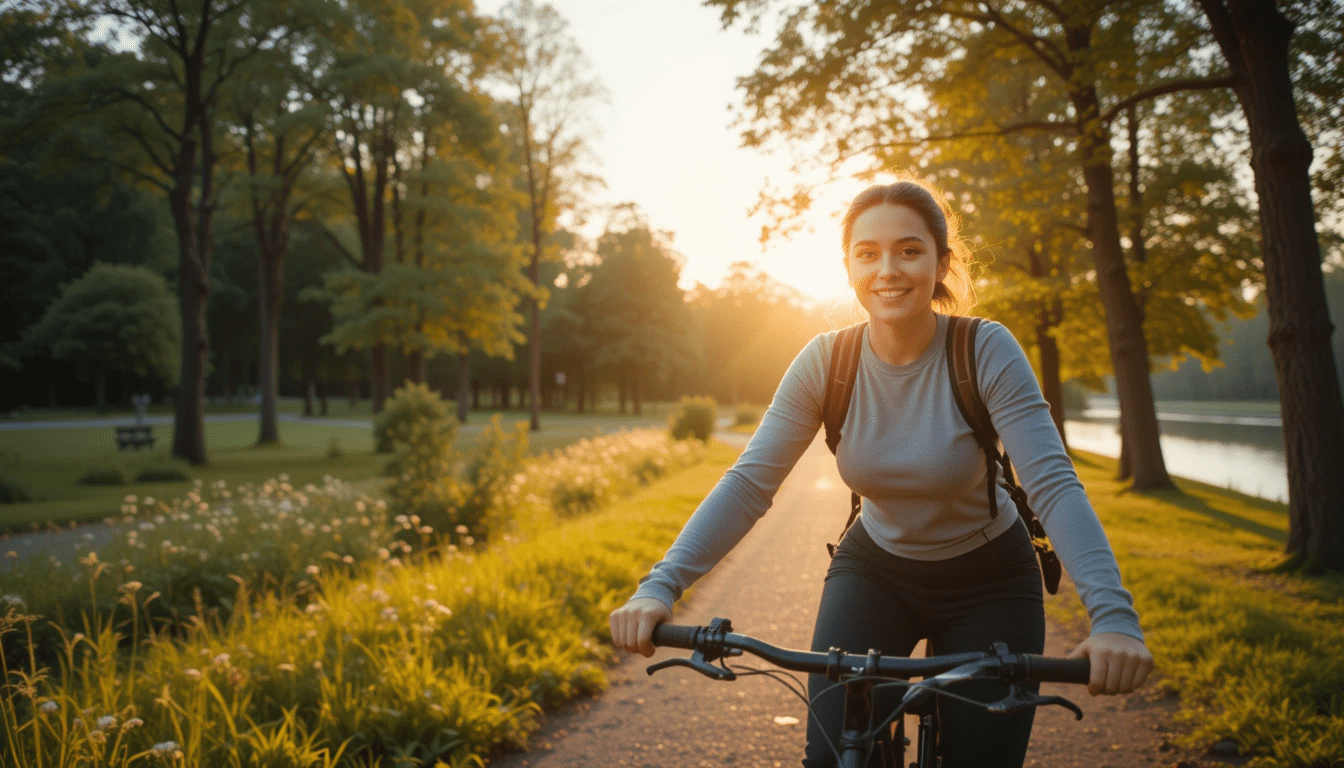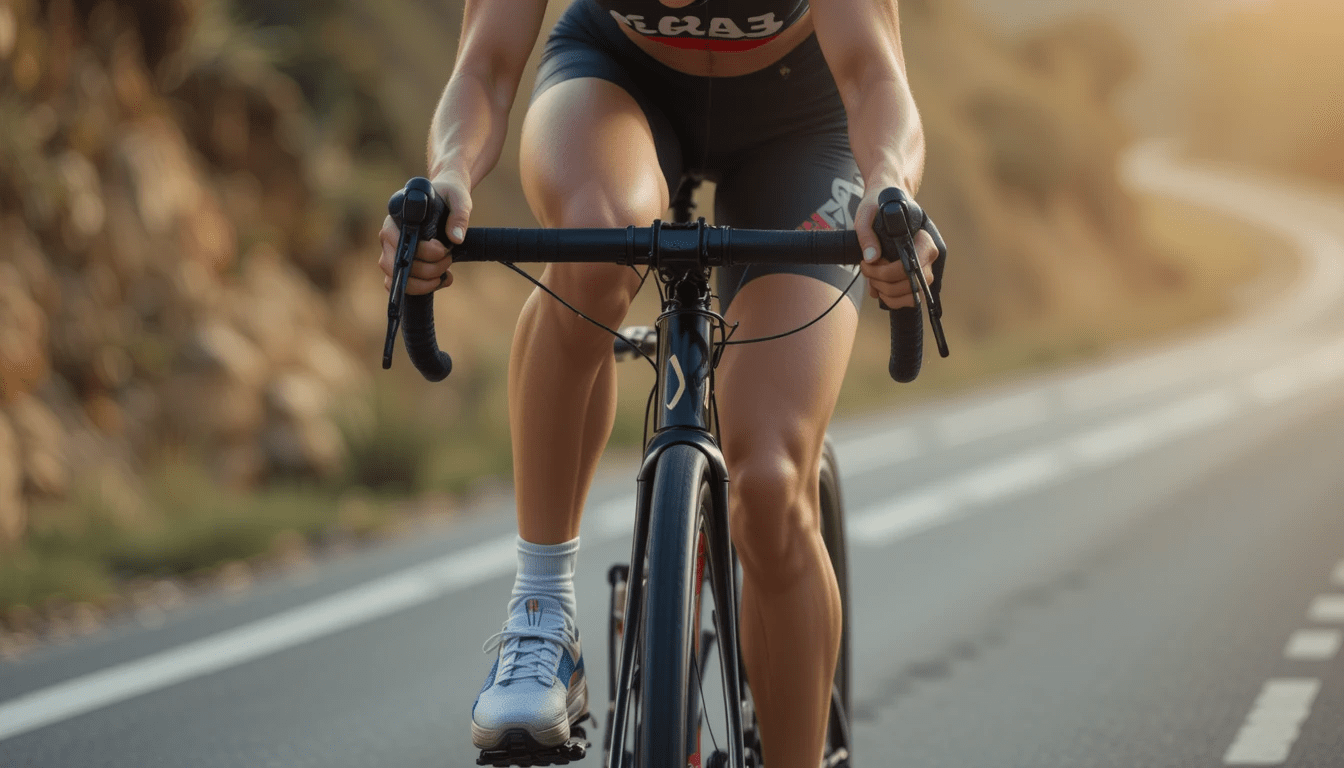Cycling mainly focuses on the muscles of the legs and trunk. It can also deliver a complete workout when done while standing up or during vigorous exertion.
Cycling is considered a full-body workout, engaging various muscle groups beyond just the legs. While cycling, you'll feel your back, abs, and arms working in tandem with your lower body. Achieving balance on the bike also requires coordination and engagement of muscles throughout the body.
In this blog post, we’ll explore five specific body areas that cycling can benefit, while also explaining the surprising full-body benefits of cycling.
Is Cycling A Full-Body Workout? 5 Muscle Areas Revealed

Your entire body can benefit from cycling. Let’s explore how cycling engages different muscle groups and improves overall fitness.
Upper Body Engagement While Cycling
Cyclists mainly target three key muscle groups in their upper body. The triceps and pectorals offer crucial support for upper body weight, while the latissimus dorsi plays a significant role in handling the push and pull actions of the handlebars.
Does Cycling Work Your Arms and Shoulders
While cycling is often associated with lower body strength, it also engages the upper body, particularly the arms and shoulders. Cyclists use their arms and shoulders to maintain balance, control the handlebars, and support the body's weight, which can lead to the toning and strengthening of these muscle groups.
Examining How Cycling Can Tone and Strengthen the Upper Body
Although not as intense as dedicated upper body exercises, cycling does provide some upper body engagement. Holding onto the handlebars requires arm strength, and rough terrains or long rides can enhance this effect. Over time, regular cycling can contribute to the toning of muscles in the arms, shoulders, and chest.
Upper Body Exercise Techniques and Positions
To maximize upper body engagement, cyclists can vary their hand positions on the handlebars and incorporate more standing cycling.
For instance, riding in a "drop" position (lowering the torso closer to the handlebars) candfgdfgincrease the demand on the arms and shoulders.
Also, maintaining a strong core while cycling helps in distributing effort across the upper body, providing a more balanced workout.
Core Strength and Stability in Cycling
Cycling is more than just a leg workout; it significantly impacts your core muscles. The core, which includes the abdominals, obliques, and lower back muscles, plays a crucial role in maintaining balance and proper posture on the bike. Whether you're climbing hills or navigating flat terrain, a strong core ensures stability and efficiency, lowering the risk of injury and improving overall performance.
The Role of Core Muscles in Maintaining Balance and Posture
While cycling, your core muscles work continuously to stabilize your body and keep you upright. Every time you pedal, your core engages to counterbalance the movement of your legs and maintain your upper body's position.
This ongoing engagement helps to strengthen the core over time, contributing to better posture not only on the bike but also in everyday activities.
Exercises and Tips to Engage Your Core More Effectively While Cycling
To enhance core activation during cycling, consider incorporating specific exercises and techniques:
- Planks and Side Planks: These off-bike exercises are excellent for building core strength that translates directly to cycling stability.
- Engage Your Core Actively: Focus on tightening your abdominal muscles while riding, especially when navigating turns or standing on the pedals.
- Alternate Hand Positions: Changing your grip on the handlebars can challenge your core in different ways, encouraging more dynamic engagement.
- Use Intervals: Incorporate interval training that requires quick bursts of speed or climbing, which naturally increases core activity as you work to maintain control.
Lower Body Power: The Main Focus of Cycling
Cycling primarily engages key muscle groups like the quadriceps and hamstrings in the upper leg, along with the gastrocnemius and soleus in the calf. These muscles work together in a coordinated sequence to drive the pedaling motion, with the quadriceps and hamstrings bearing the brunt of the effort during a bicycle ride.
Legs, Glutes, and Calves - The Powerhouses of Cycling
Cycling is primarily known for its ability to build strength and endurance in the lower body. This section delves into the critical role that leg muscles, particularly the quads, hamstrings, and calves, play during a cycling session.
- Strengthening Leg Muscles: Cycling offers a comprehensive workout for the legs, engaging the quadriceps, hamstrings, and calves with each pedal stroke. The repetitive motion helps in toning and building muscle endurance, making your legs stronger over time.
- Glute Activation: The glutes are also significantly engaged, especially when cycling uphill or in higher gears. This activation helps in sculpting and strengthening the buttocks, contributing to overall lower body power.
Comparing to Other Workouts
When compared to other forms of lower-body exercises like running or weightlifting, cycling provides a low-impact alternative that reduces strain on the joints while still offering substantial muscle-building benefits.
Cardiovascular Benefits: Cycling for Heart Health
Cycling is widely recognized as an excellent form of cardiovascular exercise, contributing significantly to heart health. When you cycle regularly, your heart rate increases, which helps improve blood circulation and strengthens your heart muscles. This not only enhances your cardiovascular endurance but also reduces the risk of heart-related diseases.
The Cardiovascular Benefits Of Regular Cycling:
- Improved Circulation: Regular cycling helps maintain healthy blood flow, ensuring that oxygen and nutrients get all parts of the body efficiently.
- Reduced Risk of Heart Disease: By keeping the heart active and strong, cycling can lower the likelihood of developing conditions such as coronary artery disease.
- Enhanced Endurance: Consistent cycling builds cardiovascular endurance, allowing you to perform physical activities for longer periods without fatigue.
How Cycling Enhances Endurance And Overall Heart Health
- Steady-State Training: Engaging in steady, moderate-intensity cycling sessions trains your heart to work efficiently, enhancing its ability to pump blood throughout the body.
- Interval Training: Incorporating intervals of high intensity during your rides challenges the heart, boosting both aerobic and anaerobic capacity.
- Recovery Benefits: Cycling helps improve the heart's recovery time after physical exertion, which is a key indicator of cardiovascular health.
Mental Well-being and Cycling

Incorporating cycling into your routine offers numerous mental health benefits, making it an essential part of a holistic fitness approach. Here's a look at how cycling can positively impact mental well-being.
Cycling for Stress Relief
Cycling serves as an effective tool for managing stress and enhancing mood. Here are some key points on how cycling can reduce anxiety:
- Endorphin Release: Engaging in cycling triggers the release of endorphins, the body's natural mood enhancers, which help lower anxiety levels and encourage a sense of well-being.
- Mindful Movement: The rhythmic motion of cycling can lead to a meditative state, allowing people to focus on the present moment and alleviate anxiety.
- Distraction from Stressors: Regular cycling provides a healthy distraction from daily stressors, offering a mental break that can lead to improved attitude and reduced tension.
The Role of Outdoor Cycling in Mental Wellness
Taking your cycling routine outdoors amplifies its mental health benefits. Outdoor cycling contributes to mental wellness in several ways:
- Exposure to Nature: Cycling in natural environments has been demonstrated to decrease feelings of depression and anxiety, as the serenity of nature can have a calming effect on the mind.
- Sunlight and Vitamin D: Riding under the sun raises vitamin D, which is essential for supporting good mental health and mood stability.
- Social Interaction: Group cycling activities provide opportunities for social engagement, fostering a sense of community and belonging, which is beneficial for mental wellness.
Cycling and Cognitive Function
Cycling not only enhances physical health but also plays a significant role in boosting cognitive abilities. Regular cycling can lead to:
- Improved Focus and Concentration: The aerobic nature of cycling increases blood flow to the brain, which enhances cognitive functions such as focus, concentration, and memory.
- Neuroplasticity Benefits: Engaging in physical activities like cycling promotes neuroplasticity, the brain's ability to form new connections, which is vital for learning and problem-solving.
- Mental Agility: If you Cycle regularly, it can improve mental agility, helping you perform better in tasks requiring quick thinking and decision-making.
You can experience many mental health benefits by incorporating cycling into your lifestyle, making it a powerful addition to traditional mental well-being practices.
How to Maximize Cycling Benefits: Tips
To make cycling a full-body workout, it's essential to incorporate specific techniques and movements. By consciously engaging your upper body, core, and lower body, you can enhance muscle activation throughout your ride. Focus on maintaining a strong posture, tightening your core, and using your arms to support and steer, all of which can turn a standard cycling session into a full-body workout.
Tips for Cycling Exercises and Full Body Movements
Enhance your cycling workout with these beneficial tips on exercises and full-body movements.
- Standing While Cycling: Alternating between sitting and standing while pedaling engages different muscle groups, particularly in the legs, glutes, and core.
- Upper Body Movements: Incorporate controlled arm movements and shoulder exercises during steady rides to activate the upper body.
- Core Engagement: Focus on drawing your belly button towards your spine to maintain core stability, especially when cycling on uneven terrain.
Complementary Workouts that Enhance the Full Body Benefits of Cycling
Cycling alone can provide an excellent cardiovascular workout, but pairing it with complementary exercises can maximize your full-body conditioning:
- Strength Training: Incorporate exercises like squats, lunges, and planks to build muscle strength that complements your cycling routine.
- Yoga and Stretching: Regular yoga or stretching sessions can improve flexibility, aid muscle recovery, and enhance overall cycling performance.
- Cross-Training: Engage in activities like swimming or rowing that work different muscle groups and provide a balanced fitness regimen.
Conclusion
Cycling is far more than just a leg-powered activity. With the correct posture, intensity, and a few strategic movements, it becomes a powerful full-body workout that strengthens the core, tones the upper body, boosts cardiovascular health, and enhances mental well-being. Whether you're cycling on city streets, mountain trails, or indoors on a stationary bike, the uses span nearly every major muscle group and body system.
From the arms and shoulders that stabilize your ride to the core that supports balance, and the legs that power every pedal stroke, cycling engages your entire body in a smooth, rhythmic workout. It’s also an effective way to support heart health, relieve stress, and keep your mind sharp.
The next time you get on your bike, remember that you’re not just riding for fun or transportation. You’re giving your whole body a reason to move, grow stronger, and stay healthier.
FAQs
Yes, while cycling mainly targets the lower body, it also engages the arms, shoulders, and upper back, especially when riding standing up or on rough terrain. Holding the handlebars and maintaining control work your triceps, shoulders, and chest muscles.
Absolutely. Cycling, especially uphill or in higher gears, activates the gluteal muscles. This helps tone and strengthen the buttocks over time, making it a great low-impact glute workout.


